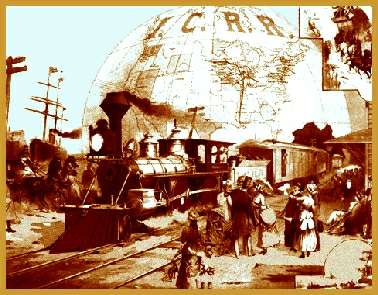PinkMonkey Study Guide - American History
7. 1 The Growth of Industry
During the pre-Civil War period, the U.S. economy was mainly agricultural. After the Civil War, industry grew at a rapid pace. Railroads were built running all the way to the Pacific coast. There was a considerable growth in the number and size of factories, lumber mills, mines, and oil wells. This, along with the ascendancy of steam and waterpower and the use of new and complex machines contributed to the growth of the American economy.
The main characteristic of economic development in the states was the emergence of large-scale business enterprise. Through the tariffs protecting American businessmen, foreign competition was kept out. The absence of tariff barriers between states gave American manufacturers one of the biggest markets of the world.
Huge business enterprise led to the development of legal institutions
like credit and insurance agencies where capital could be obtained.
Also the formation of corporations, where stocks of companies could
be bought by small investors helped in the growth of large-scale
enterprise. During the 1830s and the 1840s, the state government
adopted incorporation laws to enable any group of businessmen to
obtain a corporation charter.
The growth and expansion of railroads played a major role in the overall economic development of the nation. In the early 1800s, rail coaches with cars pulled by men made their first appearance in the U.S. Later in 1820, Stevens invented a locomotive for his New Jersey estate. In 1828 the first American railroad for general transportation was built linking Baltimore and Ohio. These were soon followed by the Hamburg and Charleston railroads in South Carolina. The 1830s saw a technological revolution in the railroad transportation. By 1860 railroads expanded to a total of 30,626 miles. This grew further to 79,168 miles in 1870. Private corporations constructed most of the railroads in the U.S. The state and federal governments assisted these projects though loans and land grants.
Also attempts were made to improve traveling conditions. For instance, in 1864, George Pulman built the first sleeping car. The swivel truck on locomotives and cars was also a significant innovation in rail transportation.

EXHIBIT 7.1
The Union Pacific Railroad was finished in 1869, joining America from coast to coast.
The growth of railroads had a great influence on
Americans. Railroads led to more settlements and migrations in the
West. The postal service became more efficient due to the expansion
in railways. Moreover, the railroads established the foundations
for several future cities in the U.S. Speaking about the contribution
of railroads, the historians -Gracbner, Fite and White
say in their book, A History of the United States: "Railroads
provided a fairly cheap, rapid and efficient means to transport
raw materials and finished products from one place to another, without
which the industrial revolution would have been impossible."
[Next Page]
|